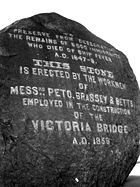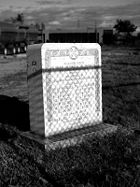
Goose Village, Montreal
Encyclopedia



Montreal
Montreal is a city in Canada. It is the largest city in the province of Quebec, the second-largest city in Canada and the seventh largest in North America...
, Quebec, Canada. Its official but less commonly used name was Victoriatown, after the adjacent Victoria Bridge. The neighbourhood was built on an area formerly known as Windmill Point, where thousands of Irish immigrants died from disease in 1847-1848.
Location
Goose Village was located near GriffintownGriffintown
Griffintown is the popular name given to the former southwestern downtown part of Montreal, Quebec, which existed from the 1820s until the 1960s and was mainly populated by Irish immigrants and their descendants....
, in what is now the southwest
Le Sud-Ouest
Le Sud-Ouest is a borough of the city of Montreal, Quebec, Canada.-Geography:Le Sud-Ouest is an amalgam of several neighbourhoods with highly distinct histories and identities, mainly with working-class and industrial origins, grouped around the Lachine Canal...
borough. The community encompassed six streets, in what is now a bus station and parking lot. The streets were named after various bridges designed by the principal engineer of the Victoria Bridge, Robert Stephenson
Robert Stephenson
Robert Stephenson FRS was an English civil engineer. He was the only son of George Stephenson, the famed locomotive builder and railway engineer; many of the achievements popularly credited to his father were actually the joint efforts of father and son.-Early life :He was born on the 16th of...
.
Typhus epidemic
Windmill Point was a quarantine area where between 3,500 and 6,000 Irish immigrants died of typhusTyphus
Epidemic typhus is a form of typhus so named because the disease often causes epidemics following wars and natural disasters...
or "ship fever," in 1847 and 1848. The immigrants had been transferred from quarantine in Grosse Isle, Quebec
Grosse Isle, Quebec
Grosse Isle Also known as Grosse Isle and the Irish Memorial National Historic Site, the island was the site of an immigration depot which predominantly housed Irish Immigrants coming to Canada to escape the Great Irish Famine, 1845-1849...
. Due to a lack of suitable preparations, typhus soon reached epidemic proportions in Montreal. Three fever sheds were initially constructed, 150 feet (45.7 m) long by 40 to 50 feet (15.2 m) wide. As thousands more sick immigrants landed, more sheds had to be erected.
The number of sheds would grow to 22, with troops cordoning off the area so the sick couldn't escape. Grey Nuns
Grey Nuns
The Order of Sisters of Charity of Montreal, formerly called The Order of Sisters of Charity of the Hôpital Général of Montreal and more commonly known as the Grey Nuns of Montreal, is a Canadian order of Roman Catholic religious sisters...
cared for the sick, carrying women and children in their arms from ships to the ambulances. According to Montreal journalist and historian Edgar Andrew Collard
Edgar Andrew Collard
Edgar Andrew Collard, CM was a Canadian journalist and historian, best known for his Montreal Gazette column "All Our Yesterdays". He was born in Montreal, Quebec....
, thirty of 40 nuns who went to help became ill, with seven dying. Other nuns took over, but once the surviving Grey Nuns had convalesced, they returned. Priests also helped, many falling ill after hearing the last confessions of the dying. When a mob threatened to throw the fever sheds into the river, Montreal mayor John Easton Mills
John Easton Mills
John Easton Mills served briefly as mayor of Montreal, Quebec.In March 1846, Montreal city council deadlocked on the choice of a mayor. Mills had ten votes, and incumbent mayor James Ferrier had nine, but Ferrier voted for himself twice, in accordance with existing rules...
quelled the riot and provided care, giving patients water and changing bedding. He died in November, serving less than a year in office. The Roman Catholic Bishop of Montreal urged French Quebecers to help their fellow Catholics. Many travelled to Montreal from the countryside to adopt children, in some cases passing their land on to them.
The Black Rock
A large black rock was erected in 1859 by workers to honour the victims, whose remains were uncovered during the construction of the Victoria Bridge. Its official English name is the Irish Commemorative Stone, but it is more commonly referred to as The Black Rock.Demolition in 1964
By 1960, most of the residents were Italian Canadians. The quaint village included St. Alphonsus School, Piche's store, and a local cafe that served what was widely regarded as the best fish and chips to be found in the larger metropolitan area of Montreal. Bus no. 2A, driven by Roland ("Flirt") Desourdie, served the community, which was home to over 300 families. Greater Montreal was preparing for Expo 67Expo 67
The 1967 International and Universal Exposition or Expo 67, as it was commonly known, was the general exhibition, Category One World's Fair held in Montreal, Quebec, Canada, from April 27 to October 29, 1967. It is considered to be the most successful World's Fair of the 20th century, with the...
, leaving the fate of the village—deemed an embarrassment by the city of Montreal and mayor Jean Drapeau
Jean Drapeau
Jean Drapeau, was a Canadian lawyer and politician who served as mayor of Montreal from 1954 to 1957 and 1960 to 1986...
— in doubt. The city created a report analyzing the living conditions in the area, which referred to a variety of drawbacks to the living conditions, which varied from many houses having no bathroom windows, to the wicked stench that came from the stockhouses in the area.http://coolopolis.blogspot.com/2007/06/goose-village-rip.html Campaigns were undertaken to save the village, but behind the scenes political maneuvers had doomed the town from the start.
The town was simply bulldozed in 1964, leaving only the fire station, train station, and the Black Rock memorial to note the passing of a proud community. The decision to raze the community put the many families out of their residences, consigning to memory the history of the village . Many of the razed homes had been built in Victorian
Victorian architecture
The term Victorian architecture refers collectively to several architectural styles employed predominantly during the middle and late 19th century. The period that it indicates may slightly overlap the actual reign, 20 June 1837 – 22 January 1901, of Queen Victoria. This represents the British and...
style, but this alone was not enough to save them from the demolition.
According to Kristian Gravenor
Kristian Gravenor
Kristian Gravenor is a Montreal news reporter and city columnist who has written over a thousand articles about the city for a variety of magazines and newspapers, starting with a column in the Westmount Examiner which he wrote at age 16. He has since written a variety of news stories for magazines...
, who conducted many interviews with former residents for a MA essay on Goose Village written in 1985, many speculated on the true causes that inspired the demolition. Some point to the urban renewal movement, which argued that poorer areas simply be demolished. Others speculated that it was a method for Drapeau to get even with his long time civic political nemesis Frank Hanley
Frank Hanley
Francis Frank Hanley was a Canadian politician of Irish descent from Montreal. -Background:He was born on April 5, 1909 in Montreal. He was the son of John Hanley, brewer, and Stella Johnson and attended St. Ann's Boys School in Montreal. Prior to his political career, he had been a boxer, a...
, who represented the area. Many former residents suspected that Drapeau wanted the unglamorous area gone, as it would be the first place on the island that visitors to Expo 67
Expo 67
The 1967 International and Universal Exposition or Expo 67, as it was commonly known, was the general exhibition, Category One World's Fair held in Montreal, Quebec, Canada, from April 27 to October 29, 1967. It is considered to be the most successful World's Fair of the 20th century, with the...
would see when arriving in Montreal via the Victoria Bridge
Victoria Bridge
Victoria Bridge may be a reference to:Crossings* Royal Victoria Dock Bridge, a footbridge across the Royal Victoria Dock near the ExCeL Exhibition Centre in London, England* Victoria Bridge, Bath, a cable-stayed bridge over the River Avon in Bath, England...
.
After the demolition
Goose Village has been referred to as "sacred" and "special" by former residents. Joe Berlettano, who led the Victoriatown Boys Club in the village from 1955-1960 referred to the small-town culture of Goose Village as "just a beautiful environment." Another former resident, Linda Frannetti, when asked whether she would return to live in the village if she could answers, "Everybody says the same thing: We'd all go back." The AutostadeAutostade
The Autostade was a Canadian football stadium in the Victoriatown neighbourhood of Montreal, Quebec that stood at the north-west corner of the Cité du Havre sector of the Expo 67 site...
— a football stadium erected for Expo 67 on part of the eight hectares where Goose Village had stood—was itself torn down in the late 1970s. Today this area is mostly uninhabited, containing light industry, a Costco
Costco
Costco Wholesale Corporation is the largest membership warehouse club chain in the United States. it is the third largest retailer in the United States, where it originated, and the ninth largest in the world...
, a train station parking lot, and undeveloped land.
Efforts by former residents of Goose Village to rebuild their community were blocked by the city, which claimed that soil in their plot of land was too polluted for residential use.

